Steam Deck vs Lenovo Legion Go: what's the best PC gaming handheld?
The PC gaming handheld powerhouses
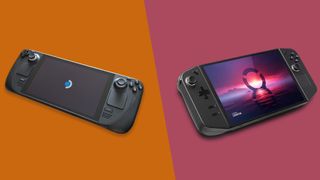
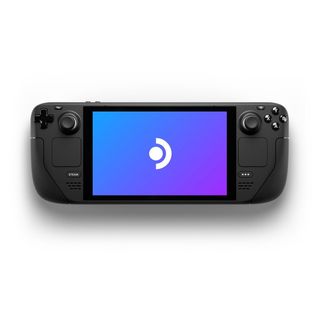
CPU: AMD Zen 2 four core 2.4-3.5GHz
Graphics: AMD RDNA 2
RAM: 16GB LPDDR5
Screen: 7-inch, 1,280 x 800 touchscreen, 60Hz
Storage: Up to 512GB PCIe SSD
Ports: USB-C, 3.5mm headphone jack, microSD
Connectivity: Wi-Fi 5, Bluetooth 5
Weight: 1.47 pounds (0.67kg)
Dimensions (W x D x H): 11.73 x 4.6 x 1.9 inches (29.8 x 11.7 x 4.9cm; W x D x H)
The original PC gaming handheld is still one of the best, but it's got some strong competition from Lenovo's powerful Legion Go.
For
- Well built
- Good performance
- Huge library of games
Against
- Slow load times
- Short battery life
- Software has some quirks

CPU: AMD Ryzen Z1 Extreme
Graphics: AMD RDNA Graphics
RAM: 16GB LPDDR5X (7500Mhz)
Screen: 8.8-inch QHD+, 144Hz, 500 nits, 97% DCI-P3
Storage: Up to 1TB M.2 2242 SSD
Ports: 2x USB Type-C, 3.5mm headphone jack, microSD
Connectivity: Wi-Fi 6, Bluetooth 5.1
Weight: 1.88 lbs | 854 g
Dimensions (W x D x H): 11.76 x 5.16 x 1.60 ins | 298.83 x 131 x 40.7 mm
The Lenovo Legion Go is one of the best gaming handhelds thanks to a powerful APU, great display, and deep customizability.
For
- Excellent performance
- Beautiful display
- Great audio quality
Against
- On the heavier side
- Some stuttering and freezing
- Software isn't great
The release of Valve's Steam Deck caused a massive shift in the gaming handheld market, with other manufacturers releasing their own versions of a PC portable machine. Devices such as the Asus ROG Ally, MSI Claw, and Lenovo Legion Go have all been aiming to unseat the Steam Deck.
The Lenovo Legion Go, in particular, is set up to be the Steam Deck rival in aesthetics, specs, and performance. But how does this PC handheld hold up against the current champ of PC handhelds? We'll compare both to see which is superior in performance and which is the overall better purchase.
Steam Deck vs Lenovo Legion Go: price

Valve’s Steam Deck costs $399 / £349 for its entry-level 64GB model. There are also OLED models, which are $549 / £479 for the 512GB model and $649 / £569 for the 1TB model.
The Lenovo Legion Go retails at $699.99 / £700 (inc. VAT) / AU$1,299 and launched on November 2023. The cheaper model comes with 16GB RAM and 512GB of storage. The more expensive $749.99 ups the storage to 1TB. Lenovo has stated that a version with the AMD Ryzen Z1 CPU is set for a future launch.
In terms of pricing, Steam Deck is the winner. Even the OLED models are cheaper than the most expensive Legion Go model and both have 1TB of storage.
Steam Deck vs Lenovo Legion Go: design & features
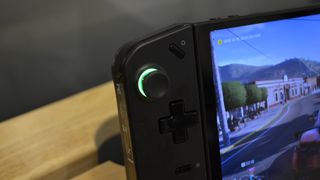
The Steam Deck and Legion Go have similar designs, with dual analog sticks, a black-heavy chassis, a large screen, and tons of buttons in the front and back of the system. Both also have ventilation exhausts on the top of the system to compensate for the massive amounts of heat generated by their components.
The Steam Deck is lighter and smaller, with a screen size of 7 inches. The OLED version upgrades the display even more. It's an efficient design that makes it comfortable to hold it up for several hours.
The larger and heavier Legion Go has an 8.8-inch QHD+ screen. The side controllers are removable joy-cons, with one able to mount on a base for FPS mode, and there's a built-in kick-stand for balancing on a flat surface. The analog sticks even have light rings that flash colors depending on battery life.
If you prize weight and size the most, the Steam Deck is the clear winner. However, the Legion has far more features built in, making it more flexible for multiple types of gaming styles and genres.
Steam Deck vs Lenovo Legion Go: specs
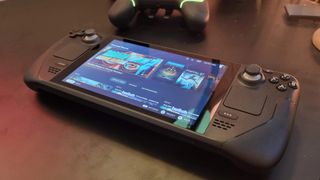
Here’s a full breakdown of the Steam Deck’s vital statistics:
- Size: 298mm x 177mm x 49mm (W x H x D)
- Weight: Approx 669 grams
- CPU: AMD Zen 2 4c/8t, 2.4-3.5GHz (up to 448 GFlops FP32)
- GPU: 8 RDNA 2 CUs, 1.0-1.6GHz (up to 1.6 Tflops FP32)
- RAM: 16GB LPDDR5 RAM
- Storage: 64GB eMMC / 256GB NVMe SSD / 512GB NVMe SSD (all models include high-speed microSD card slot)
- Display resolution: 1280 x 800px (16:10 aspect ratio)
- Display size: 7-inch diagonal
- Brightness: 400 nits typical
- Refresh rate: 60Hz
- Touch enable: Yes
- Connectivity: Bluetooth 5.0, Dual-band Wi-Fi radio, 2.4GHz and 5GHz
- Audio: Stereo speakers, dual microphone array, 3.5mm stereo headphone jack
- Power: 45W USB Type-C
- Battery life: 2 to 8 hours of gameplay
- Operating system: SteamOS 3.0
Here’s a full breakdown of the Lenovo Legion Go’s vital statistics:
- Size: 11.76 x 5.16 x 1.60 inches (298.83 x 131 x 40.7 mm; W x D x H)
- Weight: 1.88 lbs (854 g)
- Resolution: WQXGA (2560x1600)
- CPU: AMD Ryzen Z1 Extreme
- GPU: AMD RDNA Graphics
- RAM: 16GB LPDDR5X (7500Mhz)
- Storage: Up to 1TB M.2 2242 SSD
- Brightness: Up to 500 nits
- Refresh rate: 60Hz or 144Hz
- Touch enable: Yes
- Connectivity: 802.11ax 2x2 Wi-Fi + Bluetooth 5.1
- Audio: Stereo speakers, 2W x2, dual-array microphone
- Power: 49.2 Wh USB Type-C
- Operating system: Windows 11
- Video output: Up to 1080p
- USB connector: USB Type-C for charging
- 3.5mm headphone jack
- Battery life: approximately 2 to 3 hours of gameplay
- Charging time: approximately 3 hours
Steam Deck vs Lenovo Legion Go: performance
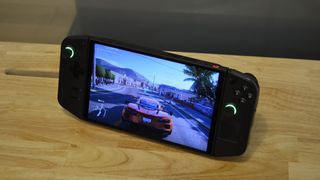
In terms of performance, the Lenovo Legion Go is objectively stronger. It has superior specs and resolution and is capable of ray tracing, all while matching the Steam Deck in terms of framerate. Visually, games look absolutely stunning on the Legion Go thanks to the 144Hz refresh rate and QHD+ screen, though the Deck's OLED is a nice boost from the original.
I tested two titles on both portables, Cyberpunk 2077 and Forza Horizon 5, to see how each fared. With Forza Horizon 5, the Legion Go had ray tracing enabled on Medium settings and was able to match the Steam Deck with above 50fps.
When it came to Cyberpunk 2077, both systems on Medium and Low matched each other at around 26fps. When I enabled ray tracing on the Legion Go, the framerate dipped to 15fps but it was still able to run.
The Steam Deck does have a better OS. While Windows 11 on the Legion Go feels more natural and easier to navigate than the Asus ROG Ally, Steam's OS is built specifically for the system, so it's faster to start up and more intuitive to use.
Overall, I have to give the victory to the Legion Go, as games look and run much better on that portable.
Steam Deck vs Lenovo Legion Go: verdict
So which is the better PC gaming handheld? It depends on what you want from one.
The Steam Deck is still king for a reason, as it offers the best balance between portability, price, and performance. It's well-rounded, allowing you to play the best PC games with an intuitive UI and decent battery power for its specs. If you're just starting out with this kind of handheld, the Steam Deck is the easy choice.
The Lenovo Legion Go is heavier and larger but with better specs and display. Games look and run smoother, and can even handle ray tracing depending on the title. It also has more features that make it more flexible for various genres and gameplay styles. However, the pricing is a big downside and it has a slower UI thanks to Windows 11.
Recently purchased a Steam Deck or Lenovo Legion Go? Consider checking out our list of the best Steam games and best PC games to get your collection going on either device.
Get daily insight, inspiration and deals in your inbox
Get the hottest deals available in your inbox plus news, reviews, opinion, analysis and more from the TechRadar team.

Named by the CTA as a CES 2023 Media Trailblazer, Allisa is a Computing Staff Writer who covers breaking news and rumors in the computing industry, as well as reviews, hands-on previews, featured articles, and the latest deals and trends. In her spare time you can find her chatting it up on her two podcasts, Megaten Marathon and Combo Chain, as well as playing any JRPGs she can get her hands on.
